|
Reality Check
|
The first CG cast of human actors stars in
Final Fantasy: The Spirits Within
|
By Barbara Robertson
|
All Images courtesy of Square Pictures, ©
Columbia Pictures.
|
Pick a science fiction film, any film. Alien, Star Wars, Men in Black,
Fifth Element, you name it. Now, imagine the same film entirely created
with 3D computer graphics-not just the visual effects, but also the people,
cities, landscapes, spaceships, sun, moon, stars, every little bit. That
exactly describes the movie Final Fantasy: The Spirits Within from Columbia
Pictures and Square. The film, which was released July 11, puts synthetic
human actors into roles that could easily have been played by real humans
and places them in completely synthetic sets. Four years in the making,
the film is one of the most ambitious computer graphics projects ever undertaken.
|

"The story could have worked as a live-action film," says Hironobu Sakaguchi,
director of the film and CEO of Square USA (Honolulu), the studio in which
a crew of around 200 people drawn from live-action films, games, commercial
production, animation, and other areas crafted Final Fantasy. "We decided
we wanted to use realistic computer graphics. Our goal was to present the
audience with something they'd never seen before."
|
The decision makes sense given Final Fantasy's starting point as a
role-playing game, and Sakaguchi's role as the originator of that interactive
game. With worldwide sales of Square's nine-part Final Fantasy series totaling
more than 26 million units, according to the company, the studio could
count on a ready-made potential audience of game-players familiar with
the fantasy themes, comfortable with computer graphics characters, and
eager to see what happens next. Sakaguchi did not choose to duplicate characters
from the video games, though. Nor did he choose a storybook style of 3D
animation, such as that in the films Shrek and Toy Story. Final Fantasy
has an original screenplay written by American screenwriters Al Reinert
and Jeff Vintar, and a style all its own.
|
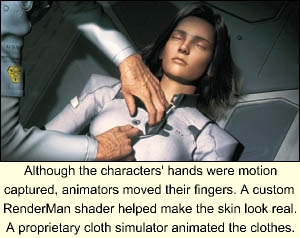
Square's filmmakers describe that style as "hyper" real not "photo"
real, noting that they tried to achieve a heightened reality in the film,
not a replicated reality. Final Fantasy doesn't look exactly like reality,
but it doesn't look exactly synthetic either. It could almost be a live-action
film that was altered for effect. The people at Square believe it could
change the way films are made in the future. "The existence of the film
itself is a great demonstration of what computer graphics can do," says
Sakaguchi, who feels now that people know it's possible to create human
characters on screen, the door is open to new ideas.
|
"It's a shot across the bow in terms of cinematography and traditional
animation," says Gary Mundell, CG Supervisor. "We can do anything we want
now. In this type of filmmaking, there are no limitations on special effects.
There are no limitations on scenery. We can put a human character into
any situation and make it do anything. There is no story that cannot be
told."
|
Square can use words like hyperreal, but it is the photorealistic look
of the film's human characters that is, arguably, the studio's most stunning
achievement. Indeed, several months before the film was released, the men's
magazine Maxim pushed aside flesh and blood women to put Final Fantasy's
star Dr. Aki Ross, wearing a bikini in a seductive pose, on the cover.
And why not? The women on magazine covers will never be anything more than
photographs to most readers anyway, and Aki is as beautiful as the rest.
|
Staging Emotions
|
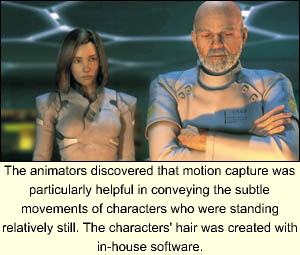
To direct the cast, Sakaguchi started with detailed frame-by-frame storyboards,
which were scanned and converted into a slide show on an Avid system. Then,
once the voice actors had recorded the script, a layout team began its
work. Using Alias|Wavefront's Maya running on SGI workstations, scenes
were blocked out with simple 3D models of characters and "filmed" with
virtual cameras. "We went to a '70s and '80s style of camera, using [virtual
equivalents of] cranes, steadi-cams, and hand-helds," says Tani Kunitake,
staging director. "We wanted a cinematic style, not a game style."
|
The storyboards and 3D layouts were both sent to the animation and
motion-capture departments. The 3D layouts showed the camera moves and
blocking for the characters timed with the voice recording; the storyboards
showed the subtext, the characters' emotions.
|

"You can't put expressions into a cubic puppet," Kunitake says, referring
to the 3D layouts. And the voice recording used for the 3D layout didn't
tell the whole story either. "Sakaguchi-san would discuss what the scene
is about visually, the relationships between Aki and Sid, Aki and Gray,"
Kunitake says. "He would discuss an emotional path that would happen in
a scene; how the characters feel. We would draw these things putting emphasis
on the story rather than the dialog."
|
Small Changes
|
Trying to turn a 3D model into an emotional and realistic human character,
though, involves a delicate balancing act: If the 3D character doesn't
look human, it doesn't matter whether it moves like a human or not-and
vice versa. But a change to the look can throw the animation off-and vice
versa.
|
"They're both challenging," says Andy Jones, animation director. "We
were always go ing back and forth with the character group about what was
more real, the character's motion or look."
|
Jones decided to have animators concentrate primarily on the characters'
faces and fingers, assigning lead animators to each character, and also
decided to use motion capture technology to help the animators move the
bodies. "Originally, we thought we'd capture 20 to 25 percent of the human
movement and the rest would be keyframed," says Remington Scott, motion
capture director. "We thought it would just be used for characters when
they're running or moving in large ways."
|
Although it was effective for recording that type of motion, the team
discovered that motion capture became even more valuable when characters
were not moving. "When characters are standing still and starting to talk
and relate to each other, there are incredible subtleties and nuances,"
Scott says. "These things are the essence of what it is to be a human,
to move like a human." Slight movements that could change the mood of a
scene, such as the way a person stands and balances his weight, or shifts
around in a chair were difficult to animate but were relatively easy to
capture. Thus, when the team began casting motion capture performers, they
looked for acting experience. Tori Eldridge, an actress and dancer with
a black belt in two martial arts performed Aki.
|

Square uses a 16-camera optical motion capture system and tracking software
from Motion Analysis; each performer wore around 35 markers, five of which
were in the chest area to capture breathing.
|
Proprietary software made it possible for Jones, Scott, and Jack Fletcher,
voice and motion capture director, to look at the motion capture data applied
to animated characters in Maya within a few minutes. "It wasn't real time,
but it was quick and extremely accurate because we could see the characters
with all the appropriate elements in Maya," says Scott.
|
Ultimately, Scott estimates, 90 percent of the body movements were
based on captured data. That data was fed into an in-house system, which
converted the captured performance into a form that could be used in Maya.
"You can scroll a character back and forth in Maya and see the motion captured
figure moving behind it like a ghost," Jones says. "If you see motion capture
actions or poses you like, you can snap to them, or you can skip sections
and animate those by hand."
|
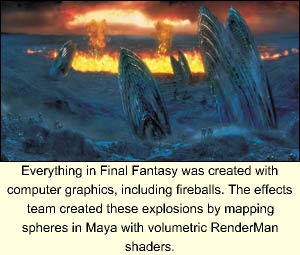
The characters' bodies were all created in Maya using a representation
of a muscle structure under the skin, and a rig that caused joints to move
bones, which moved muscles, which moved the skin. "The body had to be anatomically
correct," says Kevin Ochs, character technical director, "because we had
to worry about how the clothes would move. To keep things efficient, however,
the team worked with only as much of the body as necessary. "If you saw
a character only from the waist up, he wouldn't have legs in that shot,"
Says Ochs.
|
Moving Faces
|
Once the body performance was finished, the animators began working
on the characters' faces, which were animated entirely by hand. To help
make the skin move realistically, the technical team developed a system
that made it possible for the animators to give the skin a looser feeling
than with shape blending alone. "Blend shapes stretch or shrink the skin
from one point to another, which doesn't allow much leeway for creating
looseness in the skin," says Ochs. "We created a deformational cage that
allows us to represent muscle structure on the fly when the face starts
moving, to give the skin an elastic feel." The technical team used the
same cage, with minor modifications, for all the characters. Basically,
the cage pushes and pulls on several key points depending on the facial
expression, which causes the skin in those areas to move around the points
rather than stretch from one point to another. "We isolated points that
seem to be in constant motion while a person is talking," Ochs says.
|
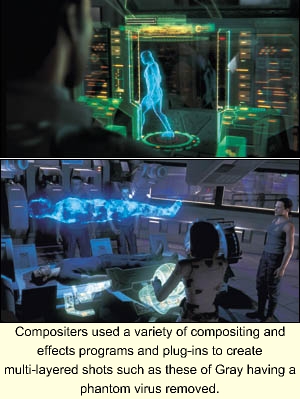
To create wrinkles, the team decided to use animated displacement maps.
"We realized that one technique was not going to give us the look we wanted,"
Ochs explains.
|
"It's extremely difficult to get the movement of the skin on the face
to look real," says Jones, "especially with how close and unrelenting our
cameras are. Like when a person frowns, little dimples and slight imperfections
appear in the skin that are so difficult to get in a CG character. You
can use animated texture maps, but if they don't perfectly match the motion
and the emotion of the character, something looks off."
|
Lighting affected the look of the animation as well. For example, Jones
explains, there's a tendency for the bottom of the trough of a wrinkle
to be a curve rather than a hard line. The curve causes a reflection of
light, which looks odd inside a wrinkle. Even though the team used techniques
within Pixar Animation Studio's RenderMan as well as in-house tools to
help solve that problem, it was difficult to make the wrinkles look real
when they moved-and there was always another CG idiosyncrasy waiting in
line.
|
"There are so many subtleties," Jones says. "We made a stylistic choice
to have our characters look as real as possible and, given that style,
to get as much emotion as we could out of them. Ultimately, I think the
look side won, especially with faces. It's just so difficult to get the
facial movement to look real."
|
Looking Real
|
To make the characters' skin look as real as possible, Ochs needed
a method that would render quickly and adapt easily to various lighting
conditions. First, he devised an algorithm that managed the consistent
properties of skin, such as how it reacts to light. Then, the team wrote
a RenderMan shader to create the inconsistent properties. By using texture
maps and procedures, this shader created approximate representations of
skin properties that varied in different areas of the body or as external
conditions changed.
|
Shades of gray from black to white in a texture map used by the shader,
for example, would indicate varying skin thickness to determine how much
light would shine through backlit ear tissue compared to fingers. And,
procedures in the shader managed such skin properties as colors and specularity.
By varying the amount of specularity, for example, the team changed the
look of the skin from oily to dry. "A character's arms would have less
oil than its face," Ochs says. "In some cases, when they're running or
under stress, we would kick up the specularity values so it would look
like they were starting to sweat." Finally, other details such as freckles
and moles were created with painted texture maps.
|
While the skin helped make the digital actors look as if they were
made of flesh and blood, creating believable hair would be the team's crowning
achievement-particularly Aki's hair. Using a proprietary system, animators
could have a simulator automatically generate and animate Aki's hair based
on her movements and settings they entered into the system. For example,
an animator could choose an "Aki running" hair setting that gave the hair
a particular kind of bounce and also specify a strong wind blowing into
her face. Or, animators could use control hairs to create specific actions
such as Aki putting her hair behind an ear. The simulator would then grow
the rest of Aki's hair and move it to match the movement of the control
hairs.
|
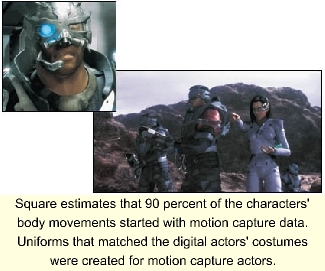
The initial hairstyles for the digital actors were all designed with
the control hairs, which were spline-based curves that acted like hair
plugs. The approximately 50 control hairs per head would be output from
Square's system as RenderMan Ri curves, and during rendering would grow
into 50,000 to 80,000 hairs, depending on the hairstyle. To shade the hair,
the team created special algorithms. "The curve doesn't have a rounded
surface, so we had to do a lot of little cheats to give a realistic look
to the hair," Ochs says. "A lot of R&D went into how lighting hits
it."
|
After it came to clothing, though, the animators got a break. When
an animator finished a character's performance, the animation was brought
into a costume file, which housed the character's body and clothes. There,
the animation was attached to the body, and the body's motion would drive
a proprietary cloth simulator. "The entire cloth simulation was done for
this movie in about a year and a half with about four people who would
set up the clothing and give it the properties it needed. It was a very
streamlined pipeline," says Ochs. Because the team designed the software
specifically for this show, they built into the program the features needed
for the movie-leather, rubber, wool, stiff collars, shoulder pads, and
so forth. "It allowed us to stay very clean and quick," Ochs says.
Being clean and quick was important: Although most astonishing, the
human stars weren't the only animated characters in Final Fantasy. The
animation team had to manage crowds of digital people in the cities, herds
of ethereal phantoms, and various kinds of vehicles, ships, and jeeps that
typify a science fiction movie. "Ev erything gets overlooked because of
the humans," says Jones. "But we had to animate anything that moved and
wasn't created with particles or effects."
|
Fantastic Effects
|
"We have craters collapsing, dust, clouds, fire, explosions, debris,"
says Remo Balcells, visual effects supervisor. "We even blow up a whole
planet." Balcells' team combined techniques used in games with RenderMan
shaders to create many of the natural effects. For example, to create fire,
they used a billboard technique. "We mapped a single polygon with a transparent
texture map that has the colors of fire on it," he explains. "And then
using a Render Man shader, we animated the texture procedurally."
|
To create smoke trails, the crew used a similar technique. "In stead
of a single rectangle, we use many of them mapped onto particles," says
Bal cells. To create the illusion of self-shadowing columns of smoke, however,
they mapped the shadows of simple spheres onto texture-mapped spheres.
Spheres were also used for fireballs created from explosions. "We'd map
the spheres with a volumetric shader and render them," he says. "It's not
a complex technique, but it requires a complex shader."
|
As production progressed, though, the team began to rely on compositing
for many atmospheric effects such as fog, which could be created more quickly
with a compositing program than with rendering. "At the beginning of the
production there was little emphasis on compositing," says James Rogers,
compositing supervisor. "It was seen as something that could add the odd
lens flare." By the end, many of the shots were composites with more than
100 layers. "A lot of people who came from live action like myself are
used to working that way," he says. The team started with Avid's Illusion,
then began working primarily with Nothing Real's Shake and Adobe's After
Effects, with Alias|Wave front's Com poser and Discreet's Flame also playing
a role. "We used anything we could get our hands on," says Rogers. "I think
that we ended up with an average of 16 layers per shot. Early last fall,
after he took on the job of CG supervisor, Mundell did an inventory of
shots that had to be completed and realized there were far too many frames
to render. By ad ding WAMnet service to the studio's 1000 Linux-based Pentiums,
300 SGI Irix CPUs, 160 Octanes, and 3 Origins, and by isolating areas that
were taking more time than others and optimizing the workflow process,
the team was able to finish three weeks ahead of schedule. "We found that
Aki's hair was taking 20 percent of all our rendering time," Mundell says,
for example. So they optimized the hair rendering and also changed such
things as texture map sizes where possible. In terms of workflow, they
tried to reduce the rendering times for shots in process and the amount
of approvals needed for each shot. "Next time it will be a lot easier,"
he says.
|
Like many people at Square, Rogers and Mundell believe that the film
is going to cause a paradigm shift. "Filmmaking has always been driven
by technology, from black and white to color, from silent to sound," Rogers
says. "I think this is one of those things. It's not necessarily the right
way to make a film, but I think it's quite significant. Filmmaking is ruled
by economics, and as the cost of technology decreases, this style of filmmaking
may become more popular. Instead of flying a crew to location x you could
create a virtual location. Instead of calling back actor x, you could do
a cutaway shot in the computer in post production."
|
Recently, a Hollywood agent who wants to represent Aki approached Sakaguchi,
a development he welcomes. "She could be hired for commercials, or other
movies," he says. Thinking about those implications could put a regular
human into hyperdrive. Would she appear as Dr. Aki Ross, the scientist,
endorsing a product? Or as the actress who played Dr. Aki Ross? And who
is that actress anyway? Is she Ming-Na, Aki's voice, Tori Eldredge who
moved her body, the modelers who built her body, the TDs who gave her flesh
and blood, or Roy Sato, the lead animator who gave her expression? Does
she exist without all these people working in concert?
|
Whether Aki becomes a star in her own right (whatever that is), there's
no question that photoreal or hyper real or simply realistic digital actors
will appear in future live-action and animated movies in important roles.
Perhaps this will open the door to actors and actresses for whom the camera
is not a friend, allowing them to become stars by stepping into camera-friendly
CG bodies and speaking through the lips of CG characters. It's easy to
imagine all sorts of possibilities-movies in which one actor plays many
roles voiced by multiple actors . . . or multiple actors playing many roles
all voiced by one actor. In the end, will the digital actors be the stars
or the people driving them?
|
It's possible that at this moment in time, the answers don't matter.
What matters is that because of Final Fantasy, we are thinking about it.
|
|
Barbara Robertson is Senior Editor, West Coast for Computer
Graphics World.
|
Computer Graphics World August, 2001
Author(s) : Barbara Robertson
|
|
|